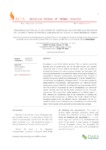Use este identificador para citar ou linkar para este item:
http://www.alice.cnptia.embrapa.br/alice/handle/doc/1062335Registro completo de metadados
| Campo DC | Valor | Idioma |
|---|---|---|
| dc.contributor.author | SIQUEIRA, G. L. de A. de | pt_BR |
| dc.contributor.author | LAZZAROTTO, M. | pt_BR |
| dc.contributor.author | FERNANDES, M. | pt_BR |
| dc.contributor.author | SILVEIRA, A. C da | pt_BR |
| dc.contributor.author | LAZZAROTTO, S. R. da S. | pt_BR |
| dc.contributor.author | CARVALHO FILHO, M. A. da S. | pt_BR |
| dc.contributor.author | LACERDA, L. G. | pt_BR |
| dc.contributor.author | QUEIROZ, D. L. de | pt_BR |
| dc.contributor.author | MIGUEL, O. G. | pt_BR |
| dc.date.accessioned | 2017-02-01T11:11:11Z | pt_BR |
| dc.date.available | 2017-02-01T11:11:11Z | pt_BR |
| dc.date.created | 2017-02-01 | pt_BR |
| dc.date.issued | 2016 | pt_BR |
| dc.identifier.citation | Brazilian Journal of Thermal Analysis, v. 5, n. 1, 2016. 6 p. | pt_BR |
| dc.identifier.uri | http://www.alice.cnptia.embrapa.br/alice/handle/doc/1062335 | pt_BR |
| dc.description | Euacalyptus is part of the national economy. This is a natural source that provides pulp for papermaking, coal for the steel industry and bioactive compounds used in various medical and industrial areas. The essential oil extracted from leaves is an important product obtained from Eucalyptus. This work evaluated essential oil extracted from leaves of Eucalyptus resistant and susceptible to Glycaspis brimblecombei using thermal tools. Samples of essential oils were extracted from crushed leaves of E. pellita (resistant) and E. camaldulenses (susceptible) by Clevenger method. The oils were analyzed by physicochemical characterization, thermogravimetry and differential thermal simultaneous analysis (TGA-DTA) and differential scanning calorimetry (DSC). The TGA curves of the essential oil from E. camaldulensis and commercial showed similarity and show that the major constituent can be 1,8-cineole. However, the TGA curves of the E. pellita essential oil has different pattern. In DSC, changing the endothermic peak of the commercial oil indicates the presence of other components or additives. The results indicate that these Eucalyptus essential oils had different chemical composition and the 1,8- cineole can be the reason of resistance and susceptibility to G. brimblecombei attack. Further studies will be performed to characterize these samples. | pt_BR |
| dc.language.iso | eng | eng |
| dc.rights | openAccess | eng |
| dc.subject | Psilídeo de concha | pt_BR |
| dc.subject | Análise térmica | pt_BR |
| dc.subject | Espécie exótica | pt_BR |
| dc.subject | Pests of plants | pt_BR |
| dc.title | Thermoanalytical evaluation of essential oils of the leaves from Eucalyptus spp susceptible and resistant to Glycaspis brimblecombei. | pt_BR |
| dc.type | Artigo de periódico | pt_BR |
| dc.date.updated | 2017-07-11T11:11:11Z | pt_BR |
| dc.subject.thesagro | Eucalipto | pt_BR |
| dc.subject.thesagro | Óleo essencial | pt_BR |
| dc.subject.thesagro | Praga de planta | pt_BR |
| dc.subject.nalthesaurus | Eucalyptus | pt_BR |
| dc.subject.nalthesaurus | Glycaspis brimblecombei | pt_BR |
| dc.subject.nalthesaurus | Essential oils | pt_BR |
| dc.subject.nalthesaurus | Thermal analysis | pt_BR |
| riaa.ainfo.id | 1062335 | pt_BR |
| riaa.ainfo.lastupdate | 2017-07-11 | pt_BR |
| dc.identifier.doi | 10.18362/bjta.v5.i1.1 | pt_BR |
| dc.contributor.institution | Geisa Liandra de Andrade de Siqueira, UEPG; MARCELO LAZZAROTTO, CNPF; Maryana Fernandes, Bolsista da Embrapa Florestas; Ana Claudia da Silveira, Bolsista da Embrapa Florestas; Simone Rosa da Silveira Lazzarotto, Doutoranda da UEPG; Marco Aurélio da Silva Carvalho Filho, Universidade Positivo; Luíz Gustavo Lacerda, Universidade Positivo; DALVA LUIZ DE QUEIROZ, CNPF; Obdúlio Gomes Miguel, Bolsista da Embrapa Florestas. | pt_BR |
| Aparece nas coleções: | Artigo em periódico indexado (CNPF)  | |
Arquivos associados a este item:
| Arquivo | Descrição | Tamanho | Formato | |
|---|---|---|---|---|
| 2016MarceloLBJTAThermoanalytical.pdf | 270.33 kB | Adobe PDF |  Visualizar/Abrir |









